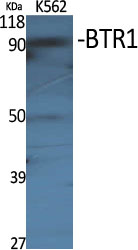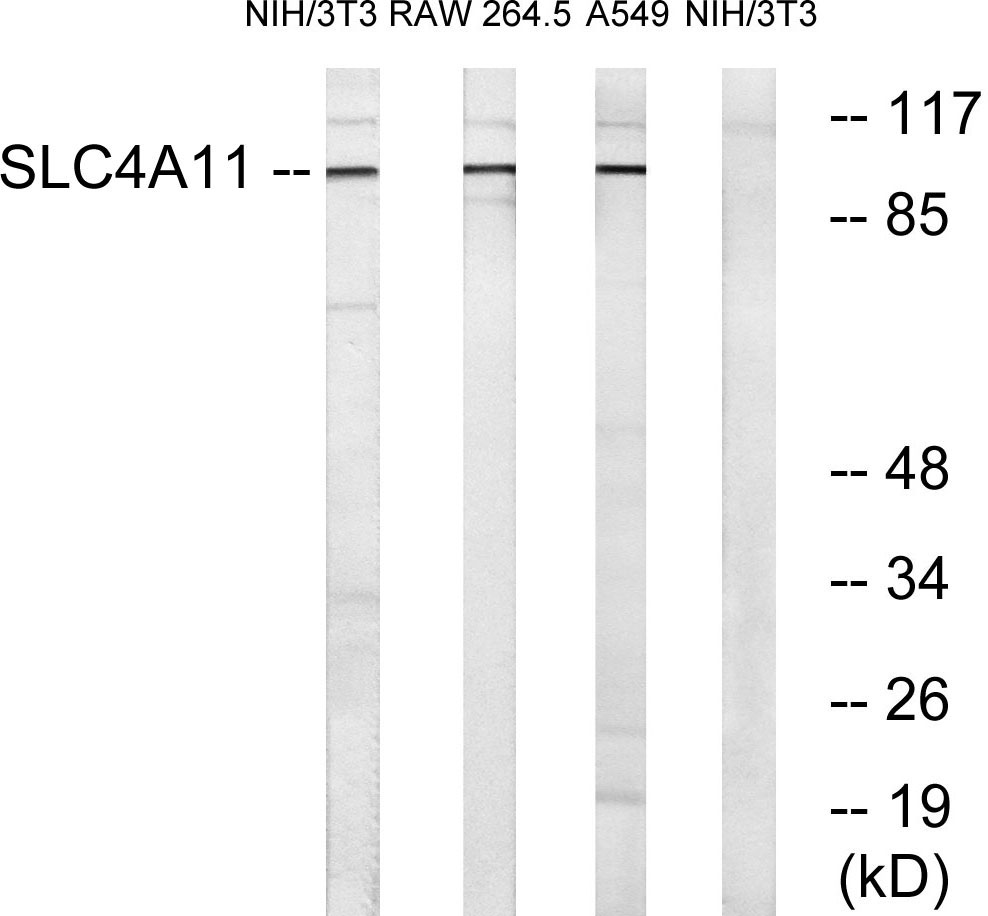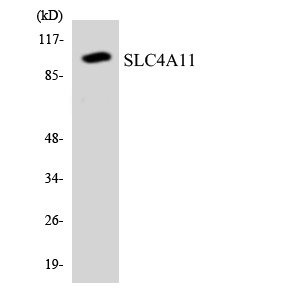BTR1 Polyclonal Antibody
- Catalog No.:YT0545
- Applications:WB;ELISA
- Reactivity:Human;Mouse
- Target:
- BTR1
- Gene Name:
- SLC4A11
- Protein Name:
- Sodium bicarbonate transporter-like protein 11
- Human Gene Id:
- 83959
- Human Swiss Prot No:
- Q8NBS3
- Mouse Swiss Prot No:
- A2AJN7
- Immunogen:
- The antiserum was produced against synthesized peptide derived from human SLC4A11. AA range:291-340
- Specificity:
- BTR1 Polyclonal Antibody detects endogenous levels of BTR1 protein.
- Formulation:
- Liquid in PBS containing 50% glycerol, 0.5% BSA and 0.02% sodium azide.
- Source:
- Polyclonal, Rabbit,IgG
- Dilution:
- WB 1:500 - 1:2000. ELISA: 1:20000. Not yet tested in other applications.
- Purification:
- The antibody was affinity-purified from rabbit antiserum by affinity-chromatography using epitope-specific immunogen.
- Concentration:
- 1 mg/ml
- Storage Stability:
- -15°C to -25°C/1 year(Do not lower than -25°C)
- Other Name:
- SLC4A11;BTR1;Sodium bicarbonate transporter-like protein 11;Bicarbonate transporter-related protein 1;Sodium borate cotransporter 1;NaBC1;Solute carrier family 4 member 11
- Observed Band(KD):
- 100kD
- Background:
- This gene encodes a voltage-regulated, electrogenic sodium-coupled borate cotransporter that is essential for borate homeostasis, cell growth and cell proliferation. Mutations in this gene have been associated with a number of endothelial corneal dystrophies including recessive corneal endothelial dystrophy 2, corneal dystrophy and perceptive deafness, and Fuchs endothelial corneal dystrophy. Multiple transcript variants encoding different isoforms have been described. [provided by RefSeq, Mar 2010],
- Function:
- disease:Defects in SLC4A11 are the cause of corneal dystrophy and perceptive deafness (CDPD) [MIM:217400]; also known as corneal dystrophy and sensorineural deafness or Harboyan syndrome. CDPD consists of congenital corneal endothelial dystrophy and progressive perceptive deafness. Inheritance is autosomal recessive.,disease:Defects in SLC4A11 are the cause of corneal endothelial dystrophy type 2 (CHED2) [MIM:217700]; also known as congenital hereditary endothelial dystrophy of cornea. This bilateral corneal dystrophy is characterized by corneal opacification and nystagmus. Inheritance is autosomal recessive.,function:Transporter involved in borate homeostasis. In the absence of borate, it functions as a Na(+) and OH(-)(H(+)) channel. In the presence of borate functions as an electrogenic Na(+) coupled borate cotransporter.,PTM:Glycosylated.,similarity:Belongs to the anion exchanger (TC
- Subcellular Location:
- Cell membrane ; Multi-pass membrane protein . Basolateral cell membrane ; Multi-pass membrane protein .
- Expression:
- Widely expressed. Highly expressed in kidney, testis, salivary gland, thyroid, trachea and corneal endothelium. Not detected in retina and lymphocytes. ; [Isoform 3]: Expressed in corneal endothelium (at protein level). ; [Isoform 5]: The predominant isoform in corneal endothelium (at protein level).
- June 19-2018
- WESTERN IMMUNOBLOTTING PROTOCOL
- June 19-2018
- IMMUNOHISTOCHEMISTRY-PARAFFIN PROTOCOL
- June 19-2018
- IMMUNOFLUORESCENCE PROTOCOL
- September 08-2020
- FLOW-CYTOMEYRT-PROTOCOL
- May 20-2022
- Cell-Based ELISA│解您多样本WB检测之困扰
- July 13-2018
- CELL-BASED-ELISA-PROTOCOL-FOR-ACETYL-PROTEIN
- July 13-2018
- CELL-BASED-ELISA-PROTOCOL-FOR-PHOSPHO-PROTEIN
- July 13-2018
- Antibody-FAQs
- Products Images

- Western Blot analysis of various cells using BTR1 Polyclonal Antibody
.jpg)
- Western Blot analysis of K562 cells using BTR1 Polyclonal Antibody

- Western blot analysis of lysates from NIH/3T3, RAW264.7, and A549 cells, using SLC4A11 Antibody. The lane on the right is blocked with the synthesized peptide.

- Western blot analysis of the lysates from HT-29 cells using SLC4A11 antibody.



